Human Resource Management Report: Tesco HRM Analysis
VerifiedAdded on 2023/01/13
|23
|6768
|53
Report
AI Summary
This report provides a comprehensive analysis of Human Resource Management (HRM) principles and practices, focusing on workforce planning, recruitment, selection, employee relations, and employment legislation. The report begins with an overview of HRM functions, emphasizing their role in workforce planning and resourcing within an organization, using Tesco as an example. It then delves into the strengths and weaknesses of various recruitment and selection approaches, including internal and external methods, and examines how HRM functions contribute to the development of talent and skills to achieve business objectives. The report also explores the benefits of different HRM practices for both employers and employees, evaluating their effectiveness in terms of profit and productivity. Furthermore, it analyzes the importance of employee relations in HRM decision-making and identifies key elements of employment legislation. Finally, the report assesses the application of HRM practices in a work-related context and provides a rationale for specific HRM practices. The report concludes with a critical evaluation of HRM practices and their application within an organizational setting, offering insights into the complexities of managing human resources effectively.
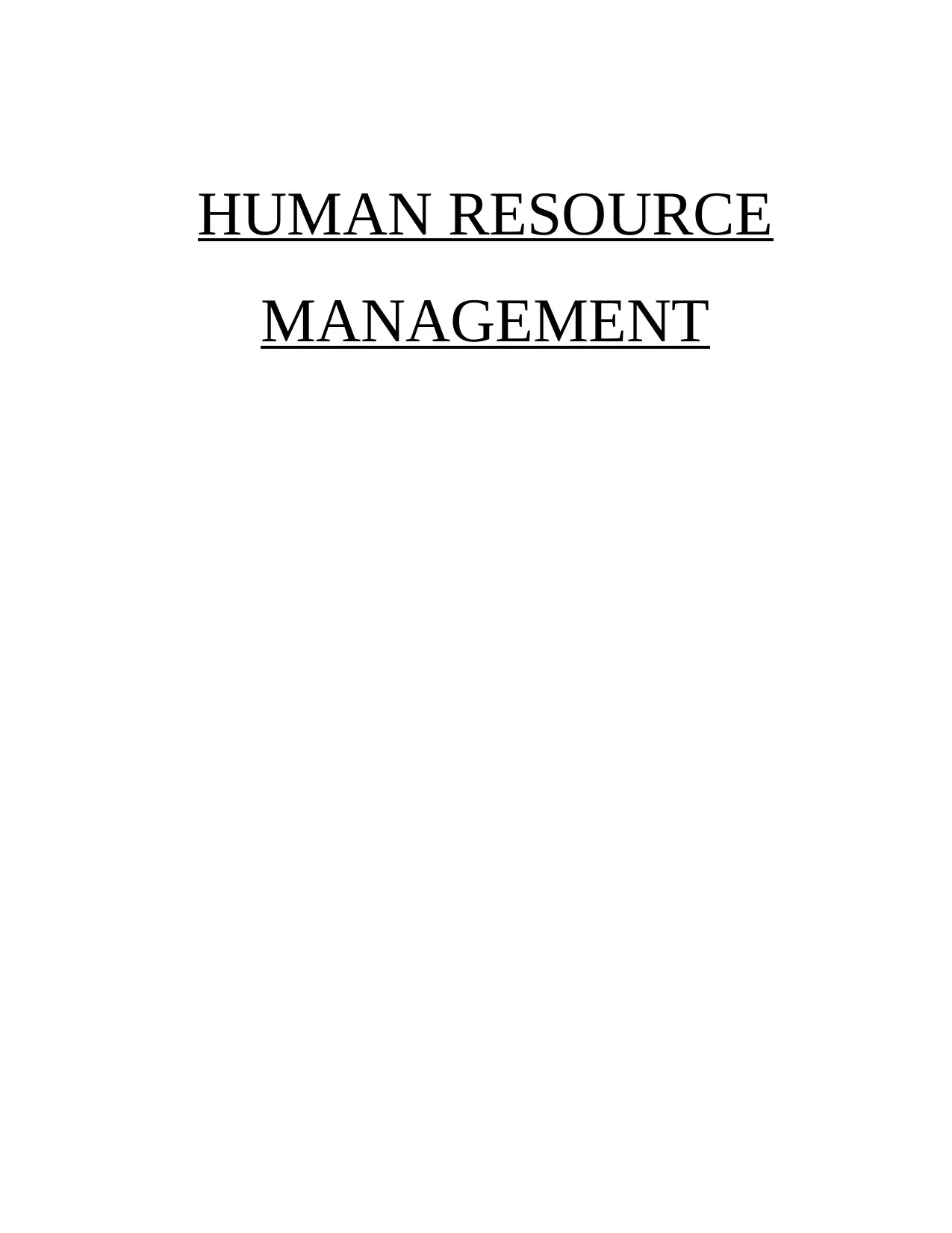
HUMAN RESOURCE
MANAGEMENT
MANAGEMENT
Paraphrase This Document
Need a fresh take? Get an instant paraphrase of this document with our AI Paraphraser
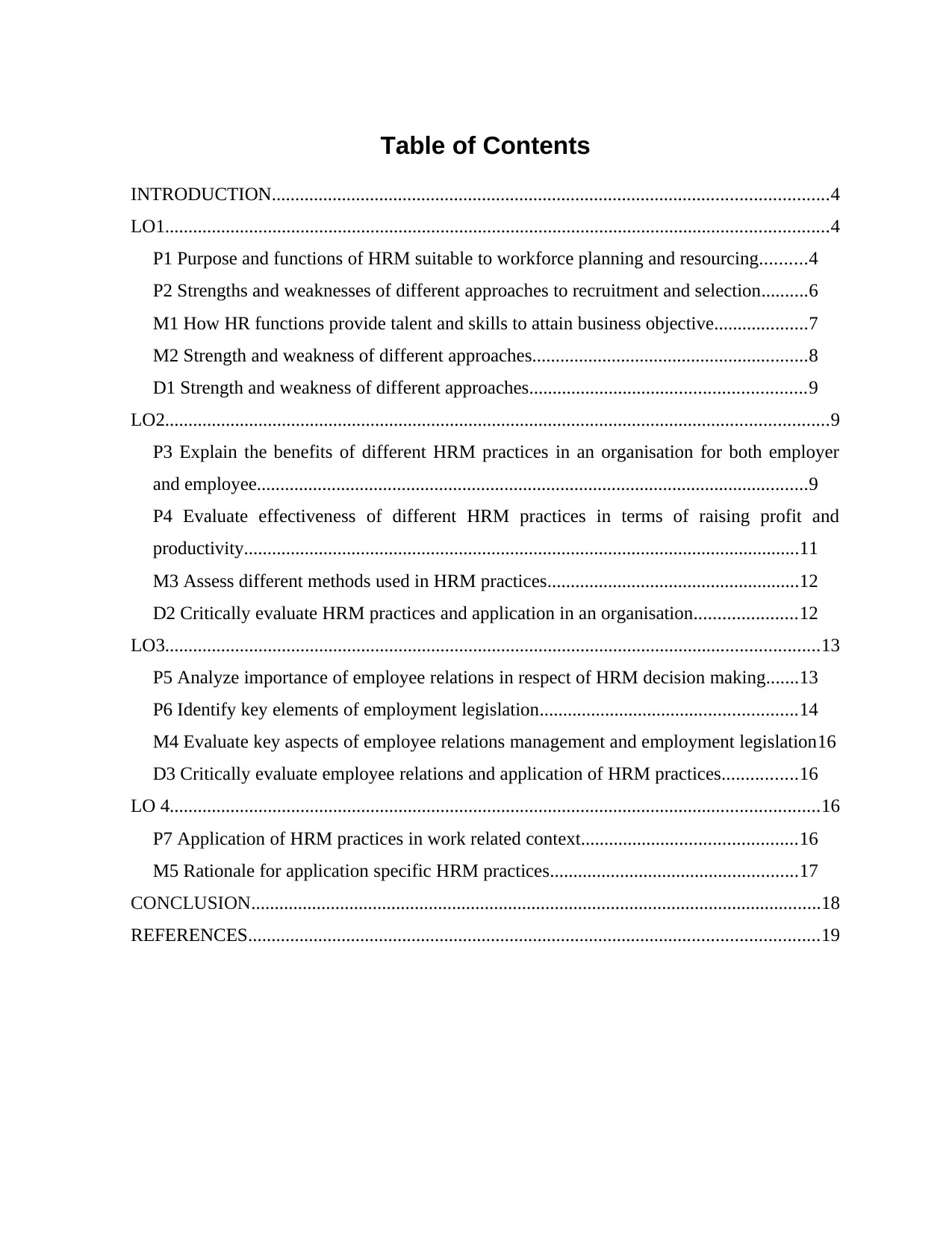
Table of Contents
INTRODUCTION.......................................................................................................................4
LO1..............................................................................................................................................4
P1 Purpose and functions of HRM suitable to workforce planning and resourcing..........4
P2 Strengths and weaknesses of different approaches to recruitment and selection..........6
M1 How HR functions provide talent and skills to attain business objective....................7
M2 Strength and weakness of different approaches...........................................................8
D1 Strength and weakness of different approaches...........................................................9
LO2..............................................................................................................................................9
P3 Explain the benefits of different HRM practices in an organisation for both employer
and employee......................................................................................................................9
P4 Evaluate effectiveness of different HRM practices in terms of raising profit and
productivity.......................................................................................................................11
M3 Assess different methods used in HRM practices......................................................12
D2 Critically evaluate HRM practices and application in an organisation......................12
LO3............................................................................................................................................13
P5 Analyze importance of employee relations in respect of HRM decision making.......13
P6 Identify key elements of employment legislation.......................................................14
M4 Evaluate key aspects of employee relations management and employment legislation16
D3 Critically evaluate employee relations and application of HRM practices................16
LO 4...........................................................................................................................................16
P7 Application of HRM practices in work related context..............................................16
M5 Rationale for application specific HRM practices.....................................................17
CONCLUSION..........................................................................................................................18
REFERENCES..........................................................................................................................19
INTRODUCTION.......................................................................................................................4
LO1..............................................................................................................................................4
P1 Purpose and functions of HRM suitable to workforce planning and resourcing..........4
P2 Strengths and weaknesses of different approaches to recruitment and selection..........6
M1 How HR functions provide talent and skills to attain business objective....................7
M2 Strength and weakness of different approaches...........................................................8
D1 Strength and weakness of different approaches...........................................................9
LO2..............................................................................................................................................9
P3 Explain the benefits of different HRM practices in an organisation for both employer
and employee......................................................................................................................9
P4 Evaluate effectiveness of different HRM practices in terms of raising profit and
productivity.......................................................................................................................11
M3 Assess different methods used in HRM practices......................................................12
D2 Critically evaluate HRM practices and application in an organisation......................12
LO3............................................................................................................................................13
P5 Analyze importance of employee relations in respect of HRM decision making.......13
P6 Identify key elements of employment legislation.......................................................14
M4 Evaluate key aspects of employee relations management and employment legislation16
D3 Critically evaluate employee relations and application of HRM practices................16
LO 4...........................................................................................................................................16
P7 Application of HRM practices in work related context..............................................16
M5 Rationale for application specific HRM practices.....................................................17
CONCLUSION..........................................................................................................................18
REFERENCES..........................................................................................................................19

⊘ This is a preview!⊘
Do you want full access?
Subscribe today to unlock all pages.

Trusted by 1+ million students worldwide
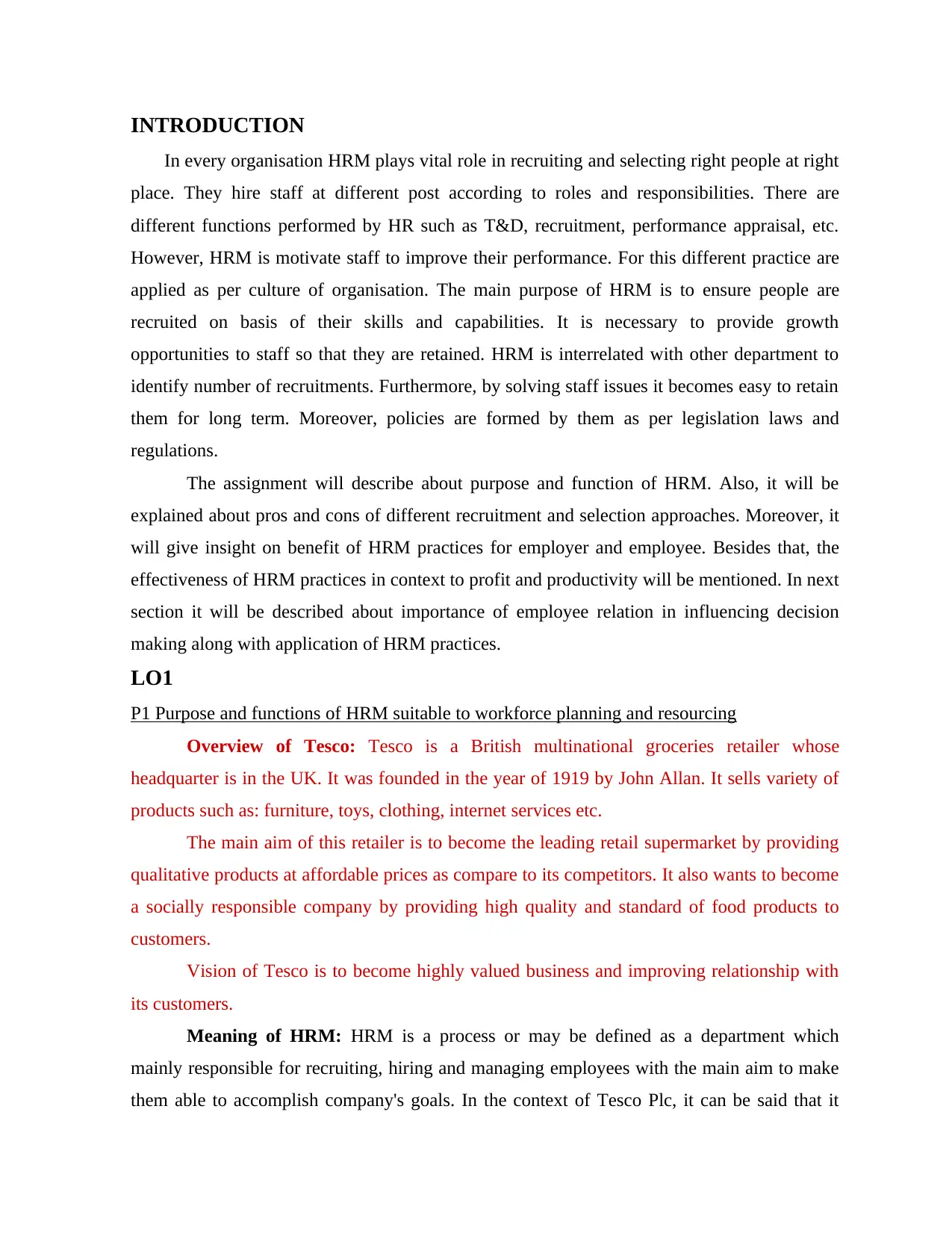
INTRODUCTION
In every organisation HRM plays vital role in recruiting and selecting right people at right
place. They hire staff at different post according to roles and responsibilities. There are
different functions performed by HR such as T&D, recruitment, performance appraisal, etc.
However, HRM is motivate staff to improve their performance. For this different practice are
applied as per culture of organisation. The main purpose of HRM is to ensure people are
recruited on basis of their skills and capabilities. It is necessary to provide growth
opportunities to staff so that they are retained. HRM is interrelated with other department to
identify number of recruitments. Furthermore, by solving staff issues it becomes easy to retain
them for long term. Moreover, policies are formed by them as per legislation laws and
regulations.
The assignment will describe about purpose and function of HRM. Also, it will be
explained about pros and cons of different recruitment and selection approaches. Moreover, it
will give insight on benefit of HRM practices for employer and employee. Besides that, the
effectiveness of HRM practices in context to profit and productivity will be mentioned. In next
section it will be described about importance of employee relation in influencing decision
making along with application of HRM practices.
LO1
P1 Purpose and functions of HRM suitable to workforce planning and resourcing
Overview of Tesco: Tesco is a British multinational groceries retailer whose
headquarter is in the UK. It was founded in the year of 1919 by John Allan. It sells variety of
products such as: furniture, toys, clothing, internet services etc.
The main aim of this retailer is to become the leading retail supermarket by providing
qualitative products at affordable prices as compare to its competitors. It also wants to become
a socially responsible company by providing high quality and standard of food products to
customers.
Vision of Tesco is to become highly valued business and improving relationship with
its customers.
Meaning of HRM: HRM is a process or may be defined as a department which
mainly responsible for recruiting, hiring and managing employees with the main aim to make
them able to accomplish company's goals. In the context of Tesco Plc, it can be said that it
In every organisation HRM plays vital role in recruiting and selecting right people at right
place. They hire staff at different post according to roles and responsibilities. There are
different functions performed by HR such as T&D, recruitment, performance appraisal, etc.
However, HRM is motivate staff to improve their performance. For this different practice are
applied as per culture of organisation. The main purpose of HRM is to ensure people are
recruited on basis of their skills and capabilities. It is necessary to provide growth
opportunities to staff so that they are retained. HRM is interrelated with other department to
identify number of recruitments. Furthermore, by solving staff issues it becomes easy to retain
them for long term. Moreover, policies are formed by them as per legislation laws and
regulations.
The assignment will describe about purpose and function of HRM. Also, it will be
explained about pros and cons of different recruitment and selection approaches. Moreover, it
will give insight on benefit of HRM practices for employer and employee. Besides that, the
effectiveness of HRM practices in context to profit and productivity will be mentioned. In next
section it will be described about importance of employee relation in influencing decision
making along with application of HRM practices.
LO1
P1 Purpose and functions of HRM suitable to workforce planning and resourcing
Overview of Tesco: Tesco is a British multinational groceries retailer whose
headquarter is in the UK. It was founded in the year of 1919 by John Allan. It sells variety of
products such as: furniture, toys, clothing, internet services etc.
The main aim of this retailer is to become the leading retail supermarket by providing
qualitative products at affordable prices as compare to its competitors. It also wants to become
a socially responsible company by providing high quality and standard of food products to
customers.
Vision of Tesco is to become highly valued business and improving relationship with
its customers.
Meaning of HRM: HRM is a process or may be defined as a department which
mainly responsible for recruiting, hiring and managing employees with the main aim to make
them able to accomplish company's goals. In the context of Tesco Plc, it can be said that it
Paraphrase This Document
Need a fresh take? Get an instant paraphrase of this document with our AI Paraphraser
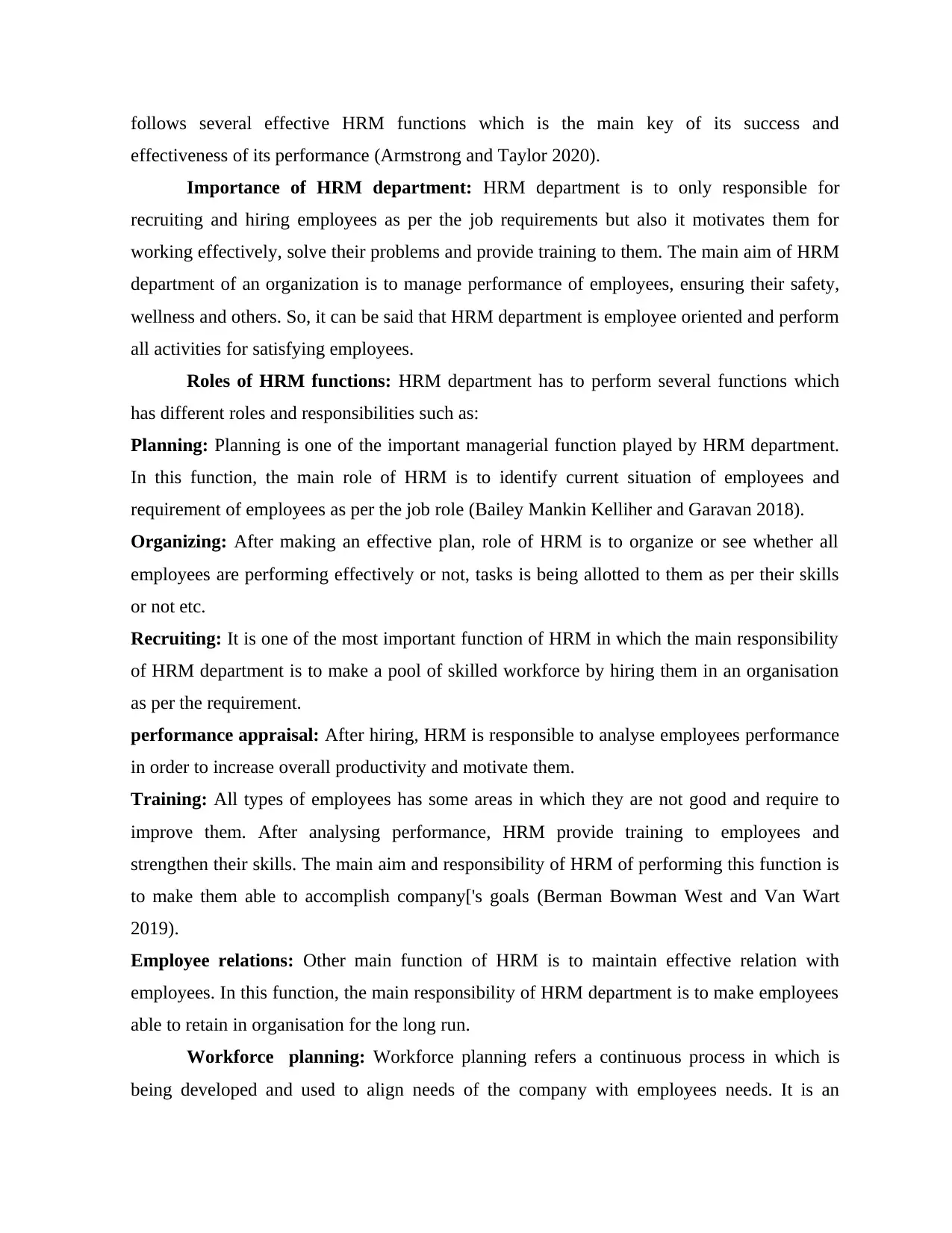
follows several effective HRM functions which is the main key of its success and
effectiveness of its performance (Armstrong and Taylor 2020).
Importance of HRM department: HRM department is to only responsible for
recruiting and hiring employees as per the job requirements but also it motivates them for
working effectively, solve their problems and provide training to them. The main aim of HRM
department of an organization is to manage performance of employees, ensuring their safety,
wellness and others. So, it can be said that HRM department is employee oriented and perform
all activities for satisfying employees.
Roles of HRM functions: HRM department has to perform several functions which
has different roles and responsibilities such as:
Planning: Planning is one of the important managerial function played by HRM department.
In this function, the main role of HRM is to identify current situation of employees and
requirement of employees as per the job role (Bailey Mankin Kelliher and Garavan 2018).
Organizing: After making an effective plan, role of HRM is to organize or see whether all
employees are performing effectively or not, tasks is being allotted to them as per their skills
or not etc.
Recruiting: It is one of the most important function of HRM in which the main responsibility
of HRM department is to make a pool of skilled workforce by hiring them in an organisation
as per the requirement.
performance appraisal: After hiring, HRM is responsible to analyse employees performance
in order to increase overall productivity and motivate them.
Training: All types of employees has some areas in which they are not good and require to
improve them. After analysing performance, HRM provide training to employees and
strengthen their skills. The main aim and responsibility of HRM of performing this function is
to make them able to accomplish company['s goals (Berman Bowman West and Van Wart
2019).
Employee relations: Other main function of HRM is to maintain effective relation with
employees. In this function, the main responsibility of HRM department is to make employees
able to retain in organisation for the long run.
Workforce planning: Workforce planning refers a continuous process in which is
being developed and used to align needs of the company with employees needs. It is an
effectiveness of its performance (Armstrong and Taylor 2020).
Importance of HRM department: HRM department is to only responsible for
recruiting and hiring employees as per the job requirements but also it motivates them for
working effectively, solve their problems and provide training to them. The main aim of HRM
department of an organization is to manage performance of employees, ensuring their safety,
wellness and others. So, it can be said that HRM department is employee oriented and perform
all activities for satisfying employees.
Roles of HRM functions: HRM department has to perform several functions which
has different roles and responsibilities such as:
Planning: Planning is one of the important managerial function played by HRM department.
In this function, the main role of HRM is to identify current situation of employees and
requirement of employees as per the job role (Bailey Mankin Kelliher and Garavan 2018).
Organizing: After making an effective plan, role of HRM is to organize or see whether all
employees are performing effectively or not, tasks is being allotted to them as per their skills
or not etc.
Recruiting: It is one of the most important function of HRM in which the main responsibility
of HRM department is to make a pool of skilled workforce by hiring them in an organisation
as per the requirement.
performance appraisal: After hiring, HRM is responsible to analyse employees performance
in order to increase overall productivity and motivate them.
Training: All types of employees has some areas in which they are not good and require to
improve them. After analysing performance, HRM provide training to employees and
strengthen their skills. The main aim and responsibility of HRM of performing this function is
to make them able to accomplish company['s goals (Berman Bowman West and Van Wart
2019).
Employee relations: Other main function of HRM is to maintain effective relation with
employees. In this function, the main responsibility of HRM department is to make employees
able to retain in organisation for the long run.
Workforce planning: Workforce planning refers a continuous process in which is
being developed and used to align needs of the company with employees needs. It is an
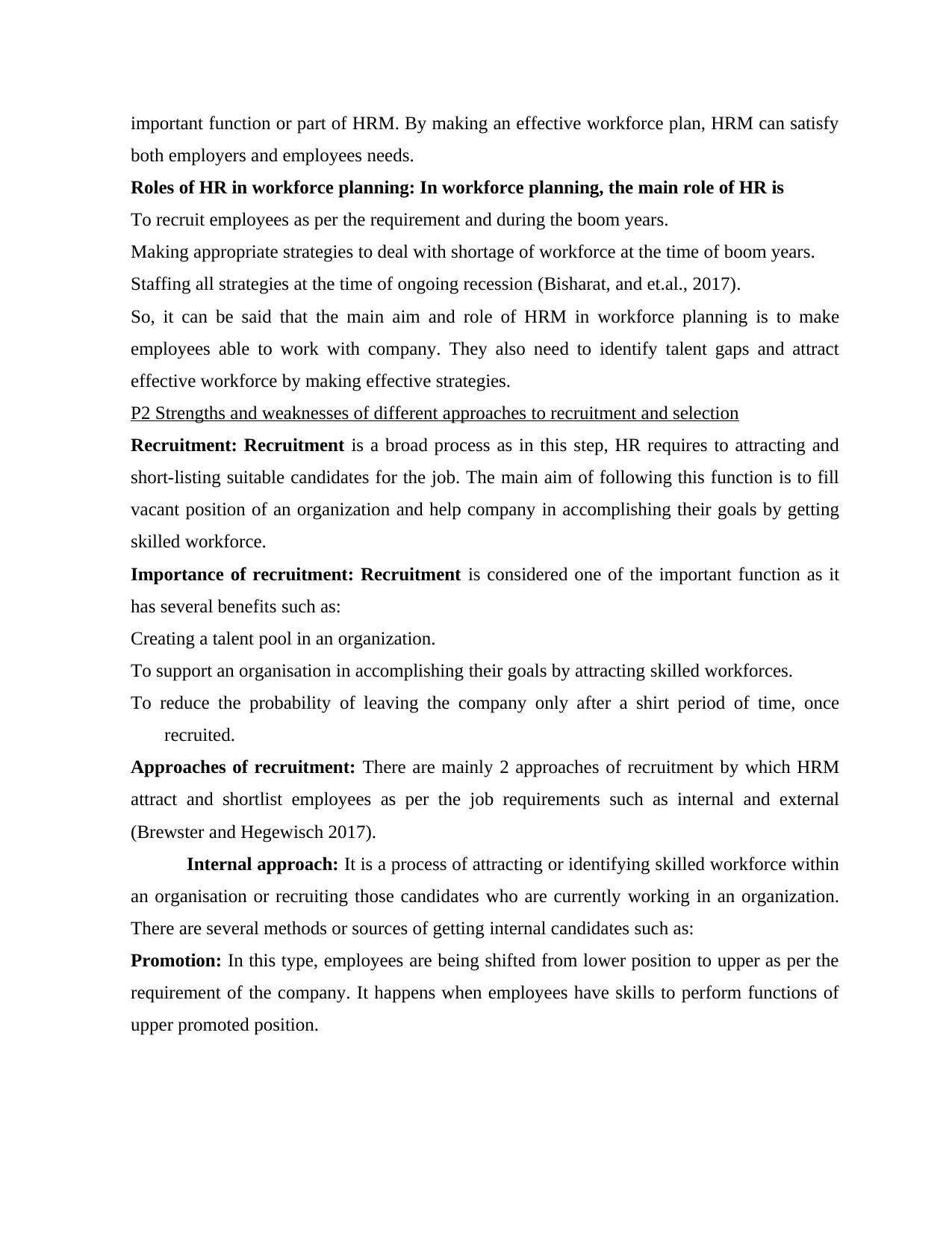
important function or part of HRM. By making an effective workforce plan, HRM can satisfy
both employers and employees needs.
Roles of HR in workforce planning: In workforce planning, the main role of HR is
To recruit employees as per the requirement and during the boom years.
Making appropriate strategies to deal with shortage of workforce at the time of boom years.
Staffing all strategies at the time of ongoing recession (Bisharat, and et.al., 2017).
So, it can be said that the main aim and role of HRM in workforce planning is to make
employees able to work with company. They also need to identify talent gaps and attract
effective workforce by making effective strategies.
P2 Strengths and weaknesses of different approaches to recruitment and selection
Recruitment: Recruitment is a broad process as in this step, HR requires to attracting and
short-listing suitable candidates for the job. The main aim of following this function is to fill
vacant position of an organization and help company in accomplishing their goals by getting
skilled workforce.
Importance of recruitment: Recruitment is considered one of the important function as it
has several benefits such as:
Creating a talent pool in an organization.
To support an organisation in accomplishing their goals by attracting skilled workforces.
To reduce the probability of leaving the company only after a shirt period of time, once
recruited.
Approaches of recruitment: There are mainly 2 approaches of recruitment by which HRM
attract and shortlist employees as per the job requirements such as internal and external
(Brewster and Hegewisch 2017).
Internal approach: It is a process of attracting or identifying skilled workforce within
an organisation or recruiting those candidates who are currently working in an organization.
There are several methods or sources of getting internal candidates such as:
Promotion: In this type, employees are being shifted from lower position to upper as per the
requirement of the company. It happens when employees have skills to perform functions of
upper promoted position.
both employers and employees needs.
Roles of HR in workforce planning: In workforce planning, the main role of HR is
To recruit employees as per the requirement and during the boom years.
Making appropriate strategies to deal with shortage of workforce at the time of boom years.
Staffing all strategies at the time of ongoing recession (Bisharat, and et.al., 2017).
So, it can be said that the main aim and role of HRM in workforce planning is to make
employees able to work with company. They also need to identify talent gaps and attract
effective workforce by making effective strategies.
P2 Strengths and weaknesses of different approaches to recruitment and selection
Recruitment: Recruitment is a broad process as in this step, HR requires to attracting and
short-listing suitable candidates for the job. The main aim of following this function is to fill
vacant position of an organization and help company in accomplishing their goals by getting
skilled workforce.
Importance of recruitment: Recruitment is considered one of the important function as it
has several benefits such as:
Creating a talent pool in an organization.
To support an organisation in accomplishing their goals by attracting skilled workforces.
To reduce the probability of leaving the company only after a shirt period of time, once
recruited.
Approaches of recruitment: There are mainly 2 approaches of recruitment by which HRM
attract and shortlist employees as per the job requirements such as internal and external
(Brewster and Hegewisch 2017).
Internal approach: It is a process of attracting or identifying skilled workforce within
an organisation or recruiting those candidates who are currently working in an organization.
There are several methods or sources of getting internal candidates such as:
Promotion: In this type, employees are being shifted from lower position to upper as per the
requirement of the company. It happens when employees have skills to perform functions of
upper promoted position.
⊘ This is a preview!⊘
Do you want full access?
Subscribe today to unlock all pages.

Trusted by 1+ million students worldwide
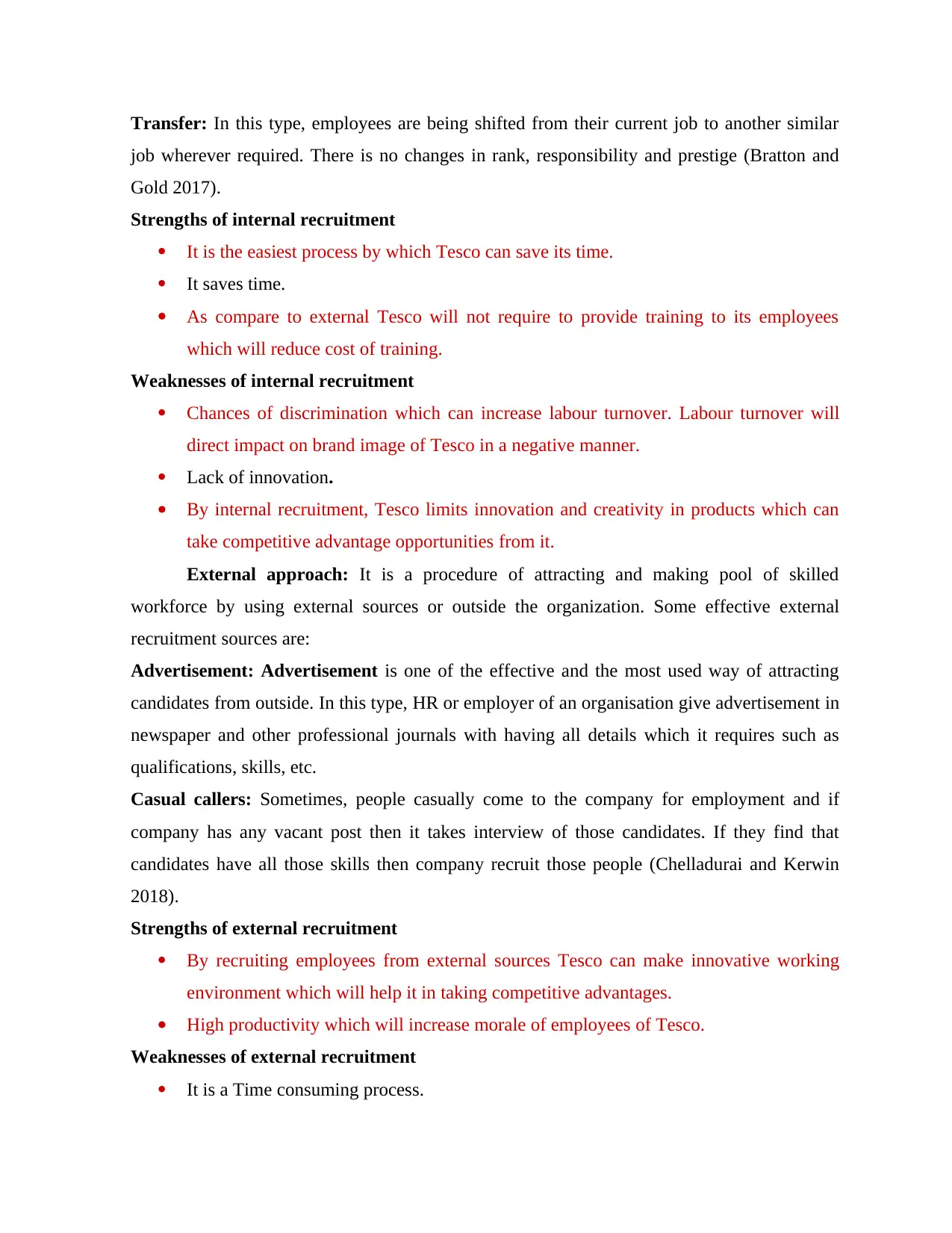
Transfer: In this type, employees are being shifted from their current job to another similar
job wherever required. There is no changes in rank, responsibility and prestige (Bratton and
Gold 2017).
Strengths of internal recruitment
It is the easiest process by which Tesco can save its time.
It saves time.
As compare to external Tesco will not require to provide training to its employees
which will reduce cost of training.
Weaknesses of internal recruitment
Chances of discrimination which can increase labour turnover. Labour turnover will
direct impact on brand image of Tesco in a negative manner.
Lack of innovation.
By internal recruitment, Tesco limits innovation and creativity in products which can
take competitive advantage opportunities from it.
External approach: It is a procedure of attracting and making pool of skilled
workforce by using external sources or outside the organization. Some effective external
recruitment sources are:
Advertisement: Advertisement is one of the effective and the most used way of attracting
candidates from outside. In this type, HR or employer of an organisation give advertisement in
newspaper and other professional journals with having all details which it requires such as
qualifications, skills, etc.
Casual callers: Sometimes, people casually come to the company for employment and if
company has any vacant post then it takes interview of those candidates. If they find that
candidates have all those skills then company recruit those people (Chelladurai and Kerwin
2018).
Strengths of external recruitment
By recruiting employees from external sources Tesco can make innovative working
environment which will help it in taking competitive advantages.
High productivity which will increase morale of employees of Tesco.
Weaknesses of external recruitment
It is a Time consuming process.
job wherever required. There is no changes in rank, responsibility and prestige (Bratton and
Gold 2017).
Strengths of internal recruitment
It is the easiest process by which Tesco can save its time.
It saves time.
As compare to external Tesco will not require to provide training to its employees
which will reduce cost of training.
Weaknesses of internal recruitment
Chances of discrimination which can increase labour turnover. Labour turnover will
direct impact on brand image of Tesco in a negative manner.
Lack of innovation.
By internal recruitment, Tesco limits innovation and creativity in products which can
take competitive advantage opportunities from it.
External approach: It is a procedure of attracting and making pool of skilled
workforce by using external sources or outside the organization. Some effective external
recruitment sources are:
Advertisement: Advertisement is one of the effective and the most used way of attracting
candidates from outside. In this type, HR or employer of an organisation give advertisement in
newspaper and other professional journals with having all details which it requires such as
qualifications, skills, etc.
Casual callers: Sometimes, people casually come to the company for employment and if
company has any vacant post then it takes interview of those candidates. If they find that
candidates have all those skills then company recruit those people (Chelladurai and Kerwin
2018).
Strengths of external recruitment
By recruiting employees from external sources Tesco can make innovative working
environment which will help it in taking competitive advantages.
High productivity which will increase morale of employees of Tesco.
Weaknesses of external recruitment
It is a Time consuming process.
Paraphrase This Document
Need a fresh take? Get an instant paraphrase of this document with our AI Paraphraser

Employing people from external sources can increase overall cost of Tesco and
decrease sales.
Company will require to provide training to all employees which can take time and
increase cost of Tesco.
Selection: It is a process of selecting qualified candidates who can meet needs of job role and
company and has potential of performing functions. There are several steps involved in
selection process such as: preliminary interview, employment tests, on the job tests etc.
Importance of selection
Selection process eliminate unsuitable candidates which are being shortlisted in
recruitment process. Company can discover the best fit from the group of recruited
candidates. It can bring innovation in its organization. Company can accomplish its
goals by getting skilled workforce (DeCenzo Robbins and Verhulst 2016).
M1 How HR functions provide talent and skills to attain business objective
In an organisation there are many functions performed by HR. It includes recruitment,
training, promotion, motivation, etc. So, by recruiting other HR provide opportunity to them
for growth. However, by hiring them for specific job role employee is able to perform tasks.
They learn skills and gain knowledge through it. Alongside, by providing them training staff
apply those learning in their work. Moreover, by motivating them HR boosts their skills. The
employee is able to show talent in attaining goals and objectives.
M2 Strength and weakness of different approaches
There are various approaches through which recruitment is done. The selection of
approach depends on requirement and efficiency of it. Also, there are other factors as well that
is considered. Along with it, each approach has its pros and cons. They are mentioned below :-
Promotion
Strength – it is easier way of recruiting staff within organisation.
There is less cost and time consumed in recruiting.
Weakness
Only selected employees are eligible for this type of recruitment.
It prevents hiring of new staff within organisation
The position remain vacant if particular person is promoted.
Transfer
decrease sales.
Company will require to provide training to all employees which can take time and
increase cost of Tesco.
Selection: It is a process of selecting qualified candidates who can meet needs of job role and
company and has potential of performing functions. There are several steps involved in
selection process such as: preliminary interview, employment tests, on the job tests etc.
Importance of selection
Selection process eliminate unsuitable candidates which are being shortlisted in
recruitment process. Company can discover the best fit from the group of recruited
candidates. It can bring innovation in its organization. Company can accomplish its
goals by getting skilled workforce (DeCenzo Robbins and Verhulst 2016).
M1 How HR functions provide talent and skills to attain business objective
In an organisation there are many functions performed by HR. It includes recruitment,
training, promotion, motivation, etc. So, by recruiting other HR provide opportunity to them
for growth. However, by hiring them for specific job role employee is able to perform tasks.
They learn skills and gain knowledge through it. Alongside, by providing them training staff
apply those learning in their work. Moreover, by motivating them HR boosts their skills. The
employee is able to show talent in attaining goals and objectives.
M2 Strength and weakness of different approaches
There are various approaches through which recruitment is done. The selection of
approach depends on requirement and efficiency of it. Also, there are other factors as well that
is considered. Along with it, each approach has its pros and cons. They are mentioned below :-
Promotion
Strength – it is easier way of recruiting staff within organisation.
There is less cost and time consumed in recruiting.
Weakness
Only selected employees are eligible for this type of recruitment.
It prevents hiring of new staff within organisation
The position remain vacant if particular person is promoted.
Transfer
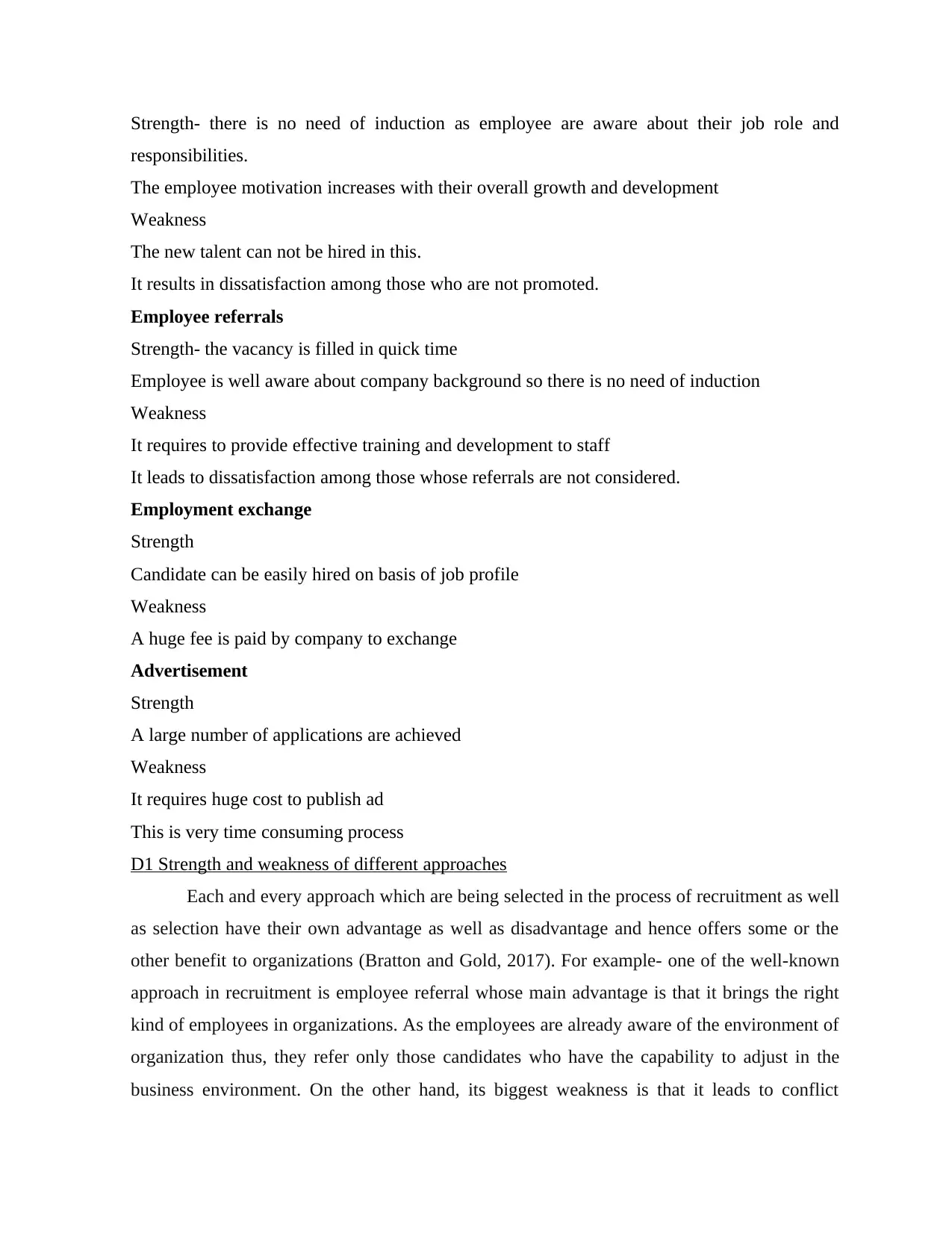
Strength- there is no need of induction as employee are aware about their job role and
responsibilities.
The employee motivation increases with their overall growth and development
Weakness
The new talent can not be hired in this.
It results in dissatisfaction among those who are not promoted.
Employee referrals
Strength- the vacancy is filled in quick time
Employee is well aware about company background so there is no need of induction
Weakness
It requires to provide effective training and development to staff
It leads to dissatisfaction among those whose referrals are not considered.
Employment exchange
Strength
Candidate can be easily hired on basis of job profile
Weakness
A huge fee is paid by company to exchange
Advertisement
Strength
A large number of applications are achieved
Weakness
It requires huge cost to publish ad
This is very time consuming process
D1 Strength and weakness of different approaches
Each and every approach which are being selected in the process of recruitment as well
as selection have their own advantage as well as disadvantage and hence offers some or the
other benefit to organizations (Bratton and Gold, 2017). For example- one of the well-known
approach in recruitment is employee referral whose main advantage is that it brings the right
kind of employees in organizations. As the employees are already aware of the environment of
organization thus, they refer only those candidates who have the capability to adjust in the
business environment. On the other hand, its biggest weakness is that it leads to conflict
responsibilities.
The employee motivation increases with their overall growth and development
Weakness
The new talent can not be hired in this.
It results in dissatisfaction among those who are not promoted.
Employee referrals
Strength- the vacancy is filled in quick time
Employee is well aware about company background so there is no need of induction
Weakness
It requires to provide effective training and development to staff
It leads to dissatisfaction among those whose referrals are not considered.
Employment exchange
Strength
Candidate can be easily hired on basis of job profile
Weakness
A huge fee is paid by company to exchange
Advertisement
Strength
A large number of applications are achieved
Weakness
It requires huge cost to publish ad
This is very time consuming process
D1 Strength and weakness of different approaches
Each and every approach which are being selected in the process of recruitment as well
as selection have their own advantage as well as disadvantage and hence offers some or the
other benefit to organizations (Bratton and Gold, 2017). For example- one of the well-known
approach in recruitment is employee referral whose main advantage is that it brings the right
kind of employees in organizations. As the employees are already aware of the environment of
organization thus, they refer only those candidates who have the capability to adjust in the
business environment. On the other hand, its biggest weakness is that it leads to conflict
⊘ This is a preview!⊘
Do you want full access?
Subscribe today to unlock all pages.

Trusted by 1+ million students worldwide
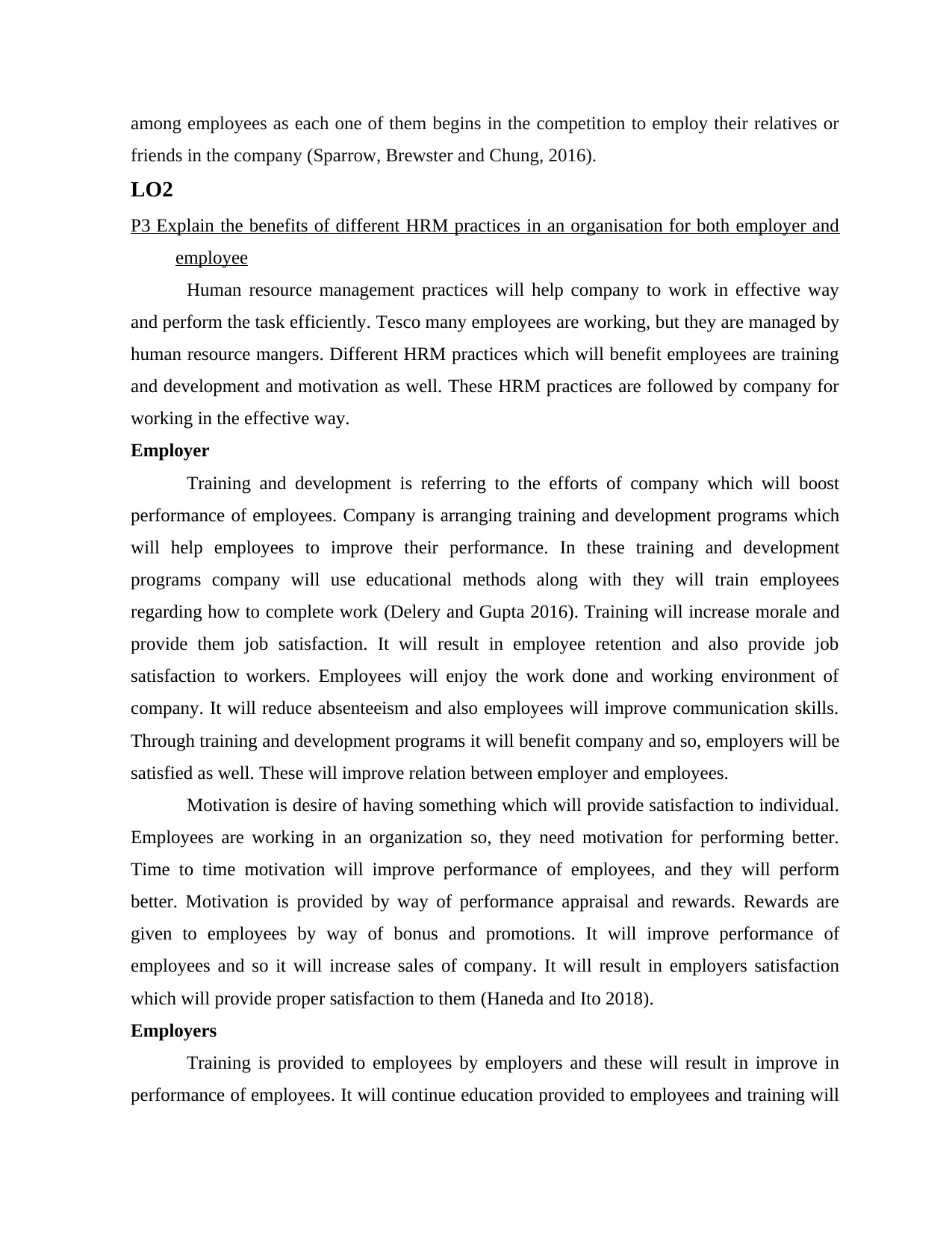
among employees as each one of them begins in the competition to employ their relatives or
friends in the company (Sparrow, Brewster and Chung, 2016).
LO2
P3 Explain the benefits of different HRM practices in an organisation for both employer and
employee
Human resource management practices will help company to work in effective way
and perform the task efficiently. Tesco many employees are working, but they are managed by
human resource mangers. Different HRM practices which will benefit employees are training
and development and motivation as well. These HRM practices are followed by company for
working in the effective way.
Employer
Training and development is referring to the efforts of company which will boost
performance of employees. Company is arranging training and development programs which
will help employees to improve their performance. In these training and development
programs company will use educational methods along with they will train employees
regarding how to complete work (Delery and Gupta 2016). Training will increase morale and
provide them job satisfaction. It will result in employee retention and also provide job
satisfaction to workers. Employees will enjoy the work done and working environment of
company. It will reduce absenteeism and also employees will improve communication skills.
Through training and development programs it will benefit company and so, employers will be
satisfied as well. These will improve relation between employer and employees.
Motivation is desire of having something which will provide satisfaction to individual.
Employees are working in an organization so, they need motivation for performing better.
Time to time motivation will improve performance of employees, and they will perform
better. Motivation is provided by way of performance appraisal and rewards. Rewards are
given to employees by way of bonus and promotions. It will improve performance of
employees and so it will increase sales of company. It will result in employers satisfaction
which will provide proper satisfaction to them (Haneda and Ito 2018).
Employers
Training is provided to employees by employers and these will result in improve in
performance of employees. It will continue education provided to employees and training will
friends in the company (Sparrow, Brewster and Chung, 2016).
LO2
P3 Explain the benefits of different HRM practices in an organisation for both employer and
employee
Human resource management practices will help company to work in effective way
and perform the task efficiently. Tesco many employees are working, but they are managed by
human resource mangers. Different HRM practices which will benefit employees are training
and development and motivation as well. These HRM practices are followed by company for
working in the effective way.
Employer
Training and development is referring to the efforts of company which will boost
performance of employees. Company is arranging training and development programs which
will help employees to improve their performance. In these training and development
programs company will use educational methods along with they will train employees
regarding how to complete work (Delery and Gupta 2016). Training will increase morale and
provide them job satisfaction. It will result in employee retention and also provide job
satisfaction to workers. Employees will enjoy the work done and working environment of
company. It will reduce absenteeism and also employees will improve communication skills.
Through training and development programs it will benefit company and so, employers will be
satisfied as well. These will improve relation between employer and employees.
Motivation is desire of having something which will provide satisfaction to individual.
Employees are working in an organization so, they need motivation for performing better.
Time to time motivation will improve performance of employees, and they will perform
better. Motivation is provided by way of performance appraisal and rewards. Rewards are
given to employees by way of bonus and promotions. It will improve performance of
employees and so it will increase sales of company. It will result in employers satisfaction
which will provide proper satisfaction to them (Haneda and Ito 2018).
Employers
Training is provided to employees by employers and these will result in improve in
performance of employees. It will continue education provided to employees and training will
Paraphrase This Document
Need a fresh take? Get an instant paraphrase of this document with our AI Paraphraser

boost morale of workers. In these process employees will also hire the best employees which
will educate the employers as well. Through these employers will be benefited because they
will get educated employees which have some skills and abilities which can be useful for
company.
Motivation is helping employees to perform better. It will create well-educated and
well motivated staff. These workers will manage work, and they feel while working in an
organization. It will reduce the cost of providing training to new employees because staff turn
over is decreased. It will improve industrial and trade relations along with it employers and
employee relation will be improved as well.
These all will benefit Tesco because through effective human resource practices
company will develop highly trained and motivated staff. These will improve performance of
employees along with company performance will be improved. So, effective human resource
mangers are managing employees of company and work of company (Kianto Sáenz and
Aramburu 2017).
P4 Evaluate effectiveness of different HRM practices in terms of raising profit and
productivity.
In these task different human resource polices are discussed and their strength and
weakness are discussed as well. Two different organization are compared and evaluate which
will state about practices which will benefit company in raising profit and productivity.
Recruitment
This is the practice which is beneficial for Sainsbury and Tesco as it brings new talent
in firm that help company in improving operations and raising productivity as well. By hiring
skilled people firm can easily meet demand. But recruitment is time consuming and costly
process because HR has to conduct interview and have to select one candidate which really
needed funds and time which is drawback of this practice.
Training
This is essential HR practice that gives benefit to Sainsbury and Tesco both. As it helps
in improving capabilities of employees by this way working efficiency can be raised. Apart
from this, this gives benefit of developing confidence of workers hence retention of them gets
increased. But conducting different training for different people is not possible hence
sometimes it becomes time consuming process because employees do not pay much attention
will educate the employers as well. Through these employers will be benefited because they
will get educated employees which have some skills and abilities which can be useful for
company.
Motivation is helping employees to perform better. It will create well-educated and
well motivated staff. These workers will manage work, and they feel while working in an
organization. It will reduce the cost of providing training to new employees because staff turn
over is decreased. It will improve industrial and trade relations along with it employers and
employee relation will be improved as well.
These all will benefit Tesco because through effective human resource practices
company will develop highly trained and motivated staff. These will improve performance of
employees along with company performance will be improved. So, effective human resource
mangers are managing employees of company and work of company (Kianto Sáenz and
Aramburu 2017).
P4 Evaluate effectiveness of different HRM practices in terms of raising profit and
productivity.
In these task different human resource polices are discussed and their strength and
weakness are discussed as well. Two different organization are compared and evaluate which
will state about practices which will benefit company in raising profit and productivity.
Recruitment
This is the practice which is beneficial for Sainsbury and Tesco as it brings new talent
in firm that help company in improving operations and raising productivity as well. By hiring
skilled people firm can easily meet demand. But recruitment is time consuming and costly
process because HR has to conduct interview and have to select one candidate which really
needed funds and time which is drawback of this practice.
Training
This is essential HR practice that gives benefit to Sainsbury and Tesco both. As it helps
in improving capabilities of employees by this way working efficiency can be raised. Apart
from this, this gives benefit of developing confidence of workers hence retention of them gets
increased. But conducting different training for different people is not possible hence
sometimes it becomes time consuming process because employees do not pay much attention
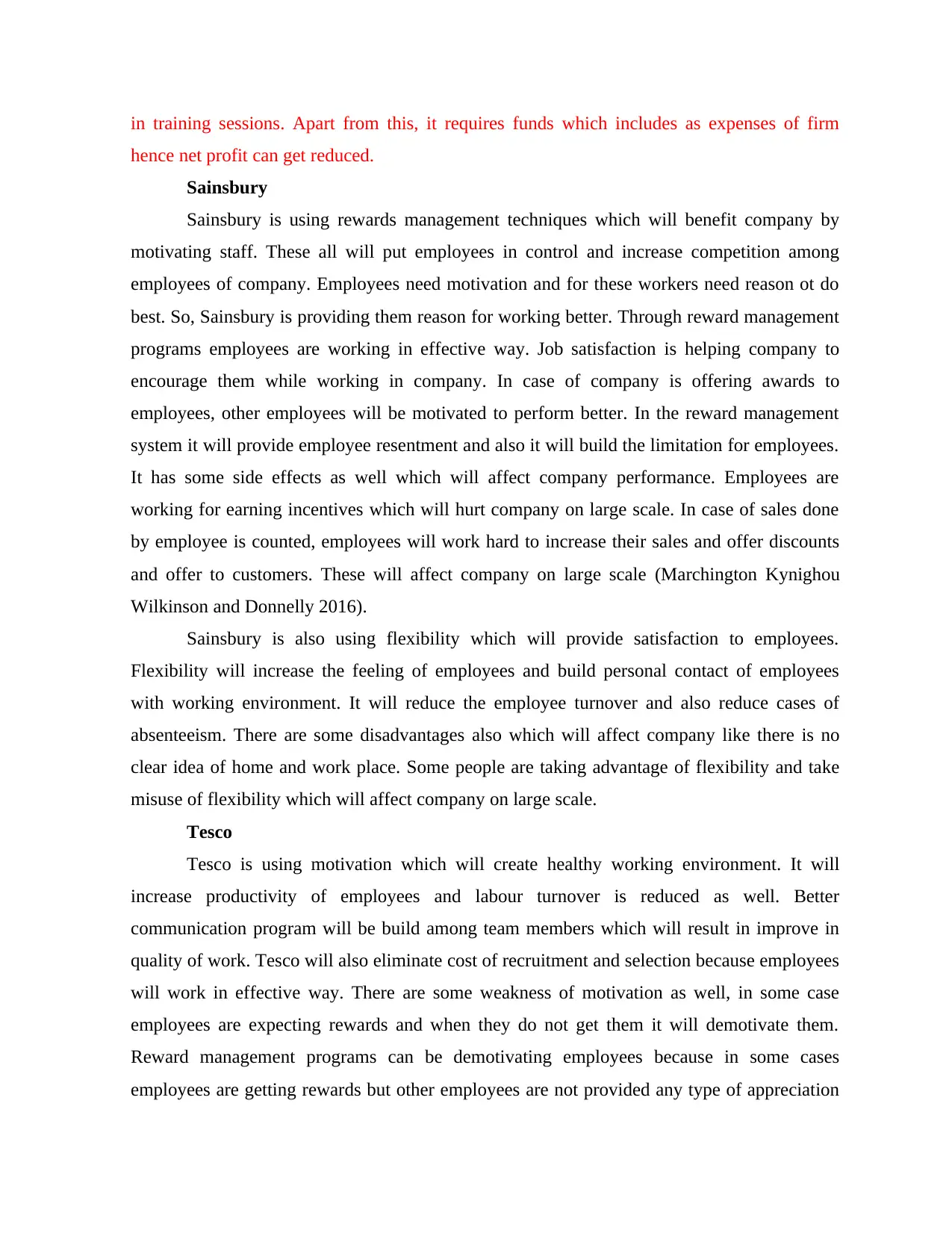
in training sessions. Apart from this, it requires funds which includes as expenses of firm
hence net profit can get reduced.
Sainsbury
Sainsbury is using rewards management techniques which will benefit company by
motivating staff. These all will put employees in control and increase competition among
employees of company. Employees need motivation and for these workers need reason ot do
best. So, Sainsbury is providing them reason for working better. Through reward management
programs employees are working in effective way. Job satisfaction is helping company to
encourage them while working in company. In case of company is offering awards to
employees, other employees will be motivated to perform better. In the reward management
system it will provide employee resentment and also it will build the limitation for employees.
It has some side effects as well which will affect company performance. Employees are
working for earning incentives which will hurt company on large scale. In case of sales done
by employee is counted, employees will work hard to increase their sales and offer discounts
and offer to customers. These will affect company on large scale (Marchington Kynighou
Wilkinson and Donnelly 2016).
Sainsbury is also using flexibility which will provide satisfaction to employees.
Flexibility will increase the feeling of employees and build personal contact of employees
with working environment. It will reduce the employee turnover and also reduce cases of
absenteeism. There are some disadvantages also which will affect company like there is no
clear idea of home and work place. Some people are taking advantage of flexibility and take
misuse of flexibility which will affect company on large scale.
Tesco
Tesco is using motivation which will create healthy working environment. It will
increase productivity of employees and labour turnover is reduced as well. Better
communication program will be build among team members which will result in improve in
quality of work. Tesco will also eliminate cost of recruitment and selection because employees
will work in effective way. There are some weakness of motivation as well, in some case
employees are expecting rewards and when they do not get them it will demotivate them.
Reward management programs can be demotivating employees because in some cases
employees are getting rewards but other employees are not provided any type of appreciation
hence net profit can get reduced.
Sainsbury
Sainsbury is using rewards management techniques which will benefit company by
motivating staff. These all will put employees in control and increase competition among
employees of company. Employees need motivation and for these workers need reason ot do
best. So, Sainsbury is providing them reason for working better. Through reward management
programs employees are working in effective way. Job satisfaction is helping company to
encourage them while working in company. In case of company is offering awards to
employees, other employees will be motivated to perform better. In the reward management
system it will provide employee resentment and also it will build the limitation for employees.
It has some side effects as well which will affect company performance. Employees are
working for earning incentives which will hurt company on large scale. In case of sales done
by employee is counted, employees will work hard to increase their sales and offer discounts
and offer to customers. These will affect company on large scale (Marchington Kynighou
Wilkinson and Donnelly 2016).
Sainsbury is also using flexibility which will provide satisfaction to employees.
Flexibility will increase the feeling of employees and build personal contact of employees
with working environment. It will reduce the employee turnover and also reduce cases of
absenteeism. There are some disadvantages also which will affect company like there is no
clear idea of home and work place. Some people are taking advantage of flexibility and take
misuse of flexibility which will affect company on large scale.
Tesco
Tesco is using motivation which will create healthy working environment. It will
increase productivity of employees and labour turnover is reduced as well. Better
communication program will be build among team members which will result in improve in
quality of work. Tesco will also eliminate cost of recruitment and selection because employees
will work in effective way. There are some weakness of motivation as well, in some case
employees are expecting rewards and when they do not get them it will demotivate them.
Reward management programs can be demotivating employees because in some cases
employees are getting rewards but other employees are not provided any type of appreciation
⊘ This is a preview!⊘
Do you want full access?
Subscribe today to unlock all pages.

Trusted by 1+ million students worldwide
1 out of 23
Related Documents
Your All-in-One AI-Powered Toolkit for Academic Success.
+13062052269
info@desklib.com
Available 24*7 on WhatsApp / Email
![[object Object]](/_next/static/media/star-bottom.7253800d.svg)
Unlock your academic potential
Copyright © 2020–2025 A2Z Services. All Rights Reserved. Developed and managed by ZUCOL.





